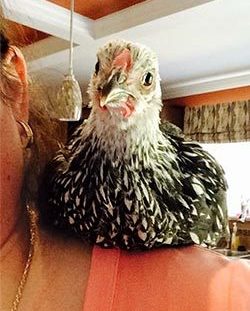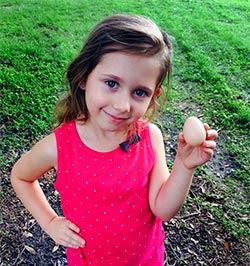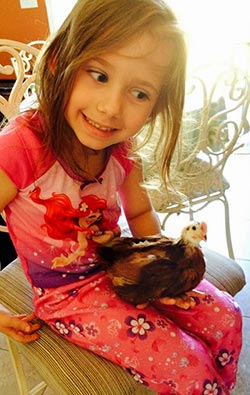What farm would be complete without a small flock of egg-laying chickens?
Just like many homesteaders, our family started their adventure into farming with a small flock of chickens to produce our own eggs. Like most stories that end up with a new or unexpected animal arriving, this one started with Justin receiving a phone call from Nichel and the girls: “Sooooo, we went to the feed store and they had these little baby [insert animal(s) here] and they were sooooooo cute!”
And suddenly we had baby chicks.
At this point, though, we didn’t have any of the typical infrastructure that you’d normally have for chickens so the only logical place that they could go was inside the house. Our house.

It was several weeks before we were able to build a proper coupe for the chickens so they got quite cozy hanging out with everyone.
Nichel and the girls played with them and everyone became quite friendly.
After our coupe was built, the flock went outside where they got to enjoy their luxurious accommodations, aka the chicken coupe. While it may not be a 4 star hotel, it does keep them safe from predators. Automatic watering systems ensure that they’re never thirsty, and large feeders ensure that they don’t run out of food.
Around six months after the ladies moved outside, we received our first egg. A few days later, we received another, then another. Over time, the chicken flock began to lay larger eggs and eventually were up to full-sized jumbo eggs like you’d buy from the grocery story. Well, with one exception. The eggs that our chickens lay are brown. Some of them can be green or blue as well. Fun fact: different breeds of chickens lay different colored eggs. Don’t worry, all of the eggs are the same inside- they all have a deep orange yolk and a clear egg-white.
All eggs are the same, right?

All eggs come from the same place, the back side of a female chicken, but that’s about it. You can find eggs of all different colors and sizes. Some are white while others have shells that are deep maroon or nearly black. Even outside of color, there are a ton of options when you go to the grocery story. Farm-fresh, all-natural, cage-free, free-range, pastured, non-GMO, organic, and the list goes on and on and on…
What’s the difference? Unfortunately, not much if you’re not purchasing your eggs from a local farmer. Most of these terms are nothing more than fancy marketing terms nowadays from the large-scale agriculture movement. “Organic” is regulated by the USDA and can’t be used on your products unless you pay your yearly fees. “Cage-free” means that the chicken isn’t in a tiny cage (even though they’re still crammed into a tight space with thousands of their friends, inside of a large chicken house).

What’s the moral of this story? That’s easy- know your farmer. Know where your food comes from and how those animals are treated. Talk to the people who are actually caring for those animals and are with them each day of their life. Talk to the people that feed them and know what they’re actually eating.
Our egg-layer chicken flock lives in a modified coupe and run style chicken house. We utilize a deep mulch system for their bedding. What’s that, you ask? A deep mulch system is essentially twelve inches or more of wood mulch from a local tree company. This mulch is piled into their coupe nice and thick and provides lots of material for the chickens to pick through and to scratch at. It also provides a nice place for bugs to live and our ladies love to eat bugs…
In addition to their chicken food, we provide them with fermented chicken food. This process adds lactobacillus bacteria to the food (the healthy bacteria found in your gut) and allows them to actually digest 80-90% of their food, compared to just 20% digestion of standard dry food. We also provide our flock with our food scraps from the dining room table for additional nutrients, minerals, and variety of food.
A high-quality diet and a stress-free life ensures that our chickens consistently lay eggs each day and that those eggs are nutrient dense and contain flavorful deep orange yolks.
Happy chickens are healthy chickens. Healthy chickens lay the best eggs.
